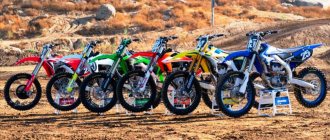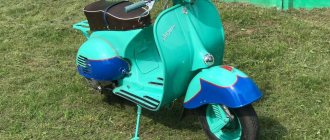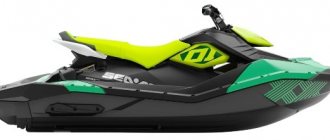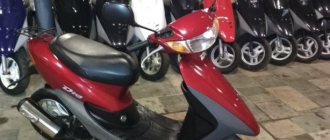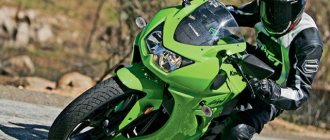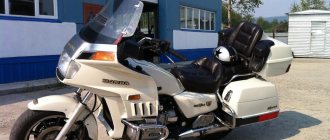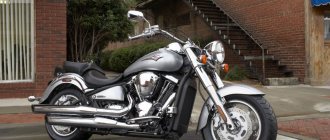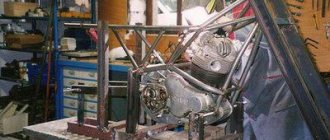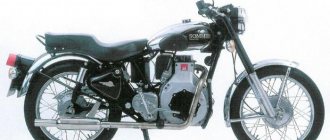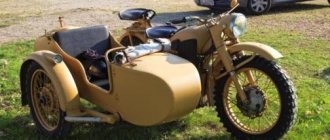Hello.
In one post we will consider two topics at once. One is for dummies: what is enduro and how enduro motorcycles differ from motocross motorcycles. The second topic is very holivar, but I will try to consider it as neutrally as possible. For advanced enthusiasts: two-stroke enduros versus four-stroke enduros.
I myself switched to a two-stroke, having previously ridden all my life on a variety of four-stroke motorcycles.
What types of enduro motorcycles are there?
1.1. Tourenduro.
Let's start from afar. Touring enduros are motorcycles for long-distance motorcycle trips with small off-road capabilities. Now the concept of a tourenduro has been greatly distorted; manufacturers have begun to produce heavy monsters, albeit with soft suspensions, but too technically complex to carry out even minor repairs in the open field. In addition, however, along with the engine size, the weight began to go off scale. All this leads to the fact that it becomes difficult to adequately ride on any surfaces more difficult than a grader, on heavy enduro motorcycles, since the rider’s buggy weight, in comparison with a loaded motorcycle, is simply no longer able to load the fork when necessary, nor work off the skid. Yes, and it’s difficult to raise, what can we talk about. The textbook example of heavy touring enduros is BMW, although a much more adequate new Africa-Twin has now been released.
KTM, which is a little more adequate in terms of the weight-engine-suspension ratio, has also long since joined the race to see who is fatter.
Medium enduros traditionally have an engine capacity in the region of 600-700 cc, although until recently, when the 701 cc Husqvarna appeared, this volume most often floated in the range of 600-690 cc. Medium enduros already allow you to move somewhere and drive a little further, even when loaded. It is much more convenient to tackle such routes as Ustyurt and Kola, for example, on medium enduros than on heavy ones. Although it will be much more boring to drive these thousands of kilometers on asphalt to the main goal of the motorcycle trip.
Examples of such motorcycles: Yamaha xt660z Tenere, BMW F650GS, KTM 690r - a little special, but in the same category, Honda XR650L - also in many ways superior to the first two and reliable as a brick, unlike the third, but also belongs to the middle enduro.
The fundamental difference between medium enduro and heavy ones is that on such motorcycles it makes sense to sometimes stand up, since they at least respond to weight management. If you see a guy driving around somewhere on a BMW r1200gs with panniers in a rack (they love this, and most often around the city) - this is just an ordinary pontoon. But the rider on the 690 KTM can already stand up for a reason.
1.2. Lightweight enduro.
Lightweight utilitarian enduro. The word “utilitarian” has become firmly entrenched in the environment of quadrics, where there are scraps that are used for stirring up local swamps around the dacha, going out into the countryside with the family, and walking back-of-the-envelope routes with the men. And there are cross-country quads, light and bouncy, with a chain drive, used in quadrocross and rally raids. Motorcycles are not called “utilitarian”, but it seems to me that this word best characterizes the lightweight enduro class Yamaha TTR250, Honda XR250-400, Suzuki Djebel, DR-Z and the like. These are light motorcycles that can be stuck into a swamp without a second thought, pushed out of there all day long... And in the end pushed out without breaking! They are also used for enduro tourism, when the route is simply a series of GPS points on the ground. Structurally, they are very simple, often even air-cooled; the service interval is calculated in kilometers, not in engine hours, and this is one of the key points.
The suspensions on such motorcycles are sometimes deliberately a throwback (forks that are not upside down for the sake of maintainability and reliability), there is a minimum of plastic, everything that is not made of plastic is strong and simple (you don’t mind dropping it even at a decent speed). In general, an ideal option for everything except long-distance driving on asphalt - it simply becomes boring!
1.3. Sports enduro.
Sports enduro are motorcycles, when creating which the manufacturer expected that they could start somewhere at least once in their life and, ideally, sometimes finish. Engines are becoming picky about the quality of the fuel they use; when they are highly boosted, they consume many times more gasoline, and service intervals are beginning to be measured not in kilometers traveled, but in engine hours. The concept of “consumables” is significantly expanded: valves, piston, timing chain, etc. are added to the oil and filters. The costs of maintaining such motorcycles are an order of magnitude higher; they are not used on the asphalt at all (although sometimes they are used to make hellish motards), so 90% of such motorcycles are cleared through customs without a title and are considered sports equipment. Vivid and common examples of such motorcycles: Yamaha WR of different cubic capacity, but mainly WR450F, Honda CRF450X, KTM EXC of different cubic capacity.
These are very light motorcycles, technologically they are an offshoot of cross-country motorcycles. Long-travel and technologically advanced suspensions, low weight and forced engines. There is no comfort, but it is not needed, since even sitting on these motorcycles they rarely ride. Such motorcycles are used for enduro racing, they are modified to take part in rally raids, and if you are in the mood, you can even jump on them on a cross-country track, although they are not suitable for full-fledged motocross training. Freeriding them is a pleasure that quickly develops into an addiction, comparable only to severe drug addiction.
It should also be added that such motorcycles are already really dangerous for a beginner, they are sharp, there is a lot of dope, and it is very easy to injure yourself.
Hard enduro. The funny thing is that this subcategory of enduro sports bikes is the most difficult to characterize. The line is completely invisible, and besides, riding skill comes to the fore here (although you can’t put it that way, since any motorcycle will never go for you in a race). Many people successfully race hard enduro on the DR-Z400, for example, which I classified as a junk car. But still, from a constructive point of view, the most important thing here is weight, despite the fact that other indicators should remain at the same level.
Due to the characteristics of driving, literally everything becomes consumable, including steering wheels and subframes. But this thrill is worth it!
If you try to explain it on your fingers, then the most common enduro locomotive, used head and shoulders in any kind of racing, the Yamaha WR450F, is not a hard enduro at all. Can you bet? It is forbidden! The Yamaha concern itself recognized this by releasing the YZ450X as an intermediate option between the enduro WR450F and the cross-country YZ450F, eliminating as much as possible everything unnecessary and lightening the design, among other modifications. Once again, the same Yamaha is back to producing two-strokes! True, as far as I understand, the YZ-X is more of a countrycross theme than a hard-endury one, but the vector for weight loss is obvious.
KTM takes off.
This is where two-strokes come into the picture, the real hard enduro monster KTM 300 EXC and clones like my TM EN 300, Gas-Gas and the much more common Husqvarna and Husaberg. They are more suitable for endurocross and hard enduro.
In general, most often, when they talk about hard enduro, they mean sports enduro in general. I don’t think this is correct, that’s why I separated these motorcycles into a separate subcategory.
Off-road motorsports news
Contrary to rumors that the “two-stroke” will never return, we can say that they never left.
KTM and Yamaha continue to sell their line of two-stroke models every year, and this is the second year Yamaha has introduced its off-road version of the FX. There are also a number of smaller European companies such as Beta and Gas-Gas. Husaberg has essentially always produced 4T models, but has now started producing 2T models.
But in this material we would like to talk about the most popular two-stroke motorcycles of the past, which are still quite competitive today and on the Internet, they can be found in very good condition. Here is the TOP 10:
1.SUZUKI RM250, 2003 – 2008
The 2008 Suzuki RM250 is just as competitive today thanks to its reliability, good suspension and powerful engine. The production of the motorcycle was discontinued after 2008, but eight years later, these models can be found on the market in very good condition and for relatively little money.
2.KTM 300, 2004 and subsequent years.
To this day, the KTM 300 is considered the best motorcycle for off-road racing and cross-country riding. The model received significant updates in 2004 (the most significant change to the model was the addition of an electric start option in 2008), but even those motorcycles that were produced between 2000 and 2003 were quite good. A 2004 motorcycle is difficult to find now, but if you do find this model, then you can buy it with confidence. Prices tend to be a little high for used KTM two-strokes.
3.Yamaha YZ250 2005 and subsequent years.
Yamaha continued to produce the 2T when the other Japanese went out of business. From 2005 to this day, the YZ has been produced with the same aluminum frame, and the changes on it are, perhaps, more cosmetic. The fork is the only component that has been significantly improved over the years. If your passion is 2T motocross, then this bike is number one and more popular than the KTM.
4.KTM 250, 2004 and subsequent years.
The KTM 250 is almost identical to the 300, but it is not as popular. Suspension has always been a sore spot on two-stroke KTMs, and remains so to this day.
5.HONDA CR250R, 2000 and 2001.
These are the best years of the Honda CR250R. The 2001 motorcycle has a second-generation aluminum frame and a better engine.
6.HONDA CR 250 R 2002-2007
Since 2002, CR has engines with an electronic power valve. The engine was a little lazier than before 2001. But the suspension was better than previous models. The model has not seen any major changes since 2002, and in 2007 Honda announced that it would no longer produce two-stroke motocross motorcycles.
7.YAMAHA YZ125 2005 and subsequent years.
The YZ125 remains the best motocross bike in its class, although it hasn't changed much in recent years. The aluminum frame has been around since 2005, but even earlier models were excellent. The Yamaha has never been the fastest 125, but it is still a well-suspension and best-handling bike.
8.Gas-Gas 250 & 300, 2000 and subsequent years.
All two-stroke Gas-Gas are excellent off-road motorcycles, and they are also quite reliable.
9.KAWASAKI KX500, 2000-2004
OLYMPUS DIGITAL CAMERA
The KX500 is the greatest desert racing bike of all time, and it remains popular among desert racing enthusiasts. No one will argue that this is a “bomb” and not a motorcycle.
10.HONDA CR500R, 2001
We're choosing the final year of the Honda CR500R. Its design has remained the same over the years, but it is the most reliable motocross bike ever built. The Honda was probably a better bike than its arch-rival Kawasaki's KX500, but it never achieved the same recognition as an off-road bike for Baja-type racing.
Differences between an enduro motorcycle and a motocross motorcycle.
In general, the most common question, for the sake of answering which we begin to understand the differences between these two types of motorcycles: is it possible to race enduro on a crossbike? This question arises because motocross motorcycles are cheaper than enduro motorcycles. Correct answer: it is possible, but up to a certain level and not just any enduro. You need to understand that a motocross motorcycle is created for riding only on a motocross track, it is sharper, designed for riding at higher speeds, to the detriment of maximum speed. There are a huge number of differences, which I remember, I will now try to include in the comparative table.
| Motocross | Enduro |
| The engine is set to high speed. | More torquey engine settings. |
| The gearbox has a long first one, for starting, the rest are short. 4-speed or 5-speed. | The first is short, so as not to poison the clutch at low speeds in plugged places. The rest are longer, there are 6-speed ones. |
| The suspension is stiffer than enduro, designed for jumping. Recently, air forks have become increasingly common. | The suspensions are relatively soft; we won’t see pneumatic forks on enduro in large numbers for a long time, if at all. |
| Small gas tank. | Large gas tank. The gas tank is a little larger, but there are a lot of ready-made tuning solutions with increased volume. |
| The absence of a headlight, tidy, or generator is actually only enough to provide a spark. | Headlight, tidy, brake light, generator, on average 60 W, a large number of tuning stators, which allows you to increase consumption. |
| Weak cooling system, not even an expansion tank. | Most often there is an expansion tank, sometimes even forced cooling fans. |
| The absence of protection, a footrest, the listed electrical elements, most often, and an electric starter = significant savings in weight. | Heavier than cross-country shoes, although removing all of the above is easier than putting it on a cross-country shoe. |
This is straight away, but if you look a little closer, you’ll even see the wheels are of different diameters! In general, if you want to race enduro, it’s better to take an enduro motorcycle. If you want motocross, take a cross bike. If you want countrycross, take it... cross country too! Completely different motorcycles, similar only in appearance. True, this understanding does not come immediately, but it always comes.
Two strokes versus four strokes.
I've ridden the YZ125, YZ250 and CR250 2-stroke bikes a bit, but my motocross skill level is too low to comment on the difference with the 4t in terms of riding performance. There is a difference between the volume; the higher it is, the less the “on-off” effect, which most riders who have never sat on a two-stroke cross-country bike are so afraid of. That's all I can say. According to my observations, the vast majority of modern motocross riders use four-stroke technology (except for kids). But I can’t comment on this trend in any way, since my motocross experience 100% matches this picture:
With enduro, not everything is so simple. Riding a 2t enduro is pleasant, efficient and interesting, which is why there are a lot of two-stroke motorcycles in modern enduro. Two-stroke enduros, unlike cross bikes, have low end engines and relatively elastic engines. Let's go point by point:
3.1. Power and elasticity.
In motocross, 125 2t is equal to 250 4t, and 250 2t is equal to 450 4t. It's the same in enduro. It would seem that then the two-strokes decide, but this is not so. Or rather, they decide, but not always. Four-stroke engines are much more flexible, while two-stroke engines are strongly tied to the characteristics of the resonator. Relatively speaking, if you install the FMF Fatty resonator, the motorcycle will jump into reverse from the bottom to the middle, but you shouldn’t even try to compete at high speeds with a four-stroke bike of the same level. Two-strokes are not rally equipment at all. Riding at 120 km/h on the WR450F is simply comfortable, while the 300 two-stroke thrashes at such high speeds that it becomes scary.
Four-stroke bikes are more elastic, which allows you to be somewhat lazy in turns and not use the clutch as actively. It is very comfortable.
On two-strokes there is an indescribable feeling of detonation when reaching resonance. This scares many people. Those who are not scared will never switch to a four-stroke bike again.
3.2. Fuel consumption.
Two-stroke motorcycles consume significantly more gas than four-stroke motorcycles. In a long race, like the XSR Countrycross, for example, where the race lasts an hour and a half, many people waste time refueling. On regular friendly rides you have to take a little oil with you, and sometimes a bottle with the ready-made mixture. Moreover, as the engine size increases, gasoline consumption increases nonlinearly: the 300 consumes one and a half times more than the 250, with a difference in volume of 1.2 times. Four-stroke engines are much more fuel efficient.
3.3. Ease of use and maintenance.
It is more convenient to use 4t, to maintain - 2t.
All you have to do is fill the four-stroke engine with gasoline and you’re good to go. Gasoline is poured into a two-stroke motorcycle mixed with special two-stroke oil, and I know people who ride durable two-stroke light enduros, such as the Suzuki RMX, which have a separate lubrication system, but I don’t know anyone who would use it, because if it If it fails, the engine will be destroyed immediately. Everything is mixed in a tank. Then habit comes, and the premix ceases to be something inconvenient, but still, it’s one whole extra step.
If the mixture is incorrect or on plug routes, when the oil does not have time to burn out, the spark plugs on two-stroke engines die. You should always have a couple of spare candles and a candle holder with you. True, in enduro this is compensated by the ability to use A17DVRM type spark plugs, which cost pennies and are sold in every general store.
Two-strokes are much more prone to carburetor freeze-up in winter. The effects are wonderful: from engine choke to throttle freezing, which is essentially the same as biting the throttle cable. It can be dangerous.
Almost all modern four-stroke engines are fuel-injected. It seems that we are just getting to the 2t injectors. Although not having to use a battery is more of a plus than a minus.
It’s not scary to sink a two-stroke boat, but with the caveat that it’s in clean water. The motorcycle is brought into combat condition after drowning in about 15 minutes. Moreover, the four-stroke rides further on the emulsion, and the two-stroke can go further almost the same way as it went down. This “almost” refers to a possible emulsion in the transmission, but there is usually such a small breather there that for it to form, the motorcycle must lie in the water for a decent amount of time.
Even a child can change the piston in a 2t. There is no timing belt, and this is a big plus, both from a repair and diagnostic point of view. More than once I saw a picture when a tired valve broke off, the mushroom fell down - and the owner received Stalingrad. This simply doesn’t happen on 2t.
3.4. Which is cheaper?
The low cost of maintaining a two-stroke is offset by the high cost of use. Two-stroke oil costs money, and over the service interval, it feels like almost the same amount accumulates that is spent on new parts when repairing a four-stroke engine. But with one caveat: if you do everything yourself. If you add the work of a mechanic to the cost of parts, then 2t is cheaper.
3.5. Driving features.
Two-stroke motorcycles have almost no engine braking. I remember how scared I was the first time I rode a two-stroke bike into a corner in motocross, which I had previously done on four-stroke bikes with the throttle off and the engine braking. But, to my surprise, nothing bad happened, on the contrary, I just started going through this turn faster. The lack of engine braking, firstly, gives a feeling of lightness. The difference in weight between 2t and 4t is actually very small, but at 2t there is a very feeling of lightness. It's hard to describe, you just have to feel it. Secondly, purely subjectively, it’s easier to drive in deep sand when the 2t doesn’t burrow so much when releasing the gas.
On two-stroke motorcycles you have to use the clutch more actively. There is no escape from this, but this is not a minus.
Choosing a motorcycle for motocross: 2T or 4T?
Everyone who decides to ride a motocross motorcycle asks himself the question: what can he do so as not to be disappointed in this sport after the first or second ride? This is a rhetorical question, although the answer is partially hidden inside: in order not to be disappointed, you need to do something. For example, train more often and approach training smarter. But this is all lyricism, there is another side - technical. We will look at the advantages and disadvantages of 2- and 4-stroke motocross motorcycles using the example of one of the most popular 250 cc motocross bikes, the Yamaha YZ series. The company continues to produce both versions, they cost about the same, although there are several fundamental differences in their design.
MOTOGONKI.RU, March 24, 2009 — Let's agree that today we are talking about sports equipment, so we will not touch on aspects of driving on public roads. Keep in mind that according to Russian laws, motocross motorcycles (in particular YZ) are not intended for highway use.
So, two bikes that look very similar to each other. The 2-stroke YZ250 is easily identified by its large black resonator, while the YZ250F exhaust system ("F" stands for "Four Stroke" - 4-stroke) is elegantly hidden within the frame. The engine and power system are what distinguish these motorcycles in the first place. Without delving into the jungle of design, the differences can be described in a nutshell as follows: a 2-stroke engine runs on gasoline, already mixed with motor oil in the required proportion; In a 4-stroke engine, gasoline and oil live separately. Thanks to this, the “two-stroke” is simple in design and cheap to operate, moreover, it has much fewer parts. But the resource of a modern “four-stroke” is much greater. The 2T exhaust system is an integral part of the engine; removing the muffler from the motorcycle will cause you to lose half the power. 4T can work without a muffler at all... until the technical commissioner arrives, who will immediately disqualify you for violating the noise rules.
Since most motorcycles are built around the engine, the chassis and suspension settings of the YZ250 and YZ250F are also different. This is due to the different “characters” of the engines and the delivery of energy to the rear wheel. The "explosive nature" of a 2-stroke engine comes through at high revs, while the energy from a 4-stroke is delivered more evenly throughout the range. Accordingly, the YZ250 shock absorbers have a different spring configuration than the YZ250F - the suspension works differently. If you swap the shock absorbers of these motorcycles, the chassis geometry of both cars will be disrupted and it will become unsafe to ride them.
The main thing that attracts athletes to two-stroke bikes is peak power. The YZ250 engine produces 46.4 hp. at 8500 rpm, while its 4-stroke brother is more than 10 hp. less - 36 hp at 11300 rpm. As for torque, here too the 2-stroke engine provides more than 30% superiority. The operating range of the YZ250 is only 3500 rpm: in order for the motorcycle to “go”, the throttle must be kept open more than 3/4. It would seem that this is it - take it and use it! But this story would not be so clear if not for the different levels of training of the athletes.
To appreciate all the advantages of a 2-stroke engine, you need to be an ace and go “at full throttle”. American cross racers are not afraid to rev the engine. Today the American school is the strongest in the world, primarily because the vast majority of participants in the American series grew up in a cross-country environment and began their journey in childhood. Many were “turned on” to motocross motorcycles by their fathers, who themselves are not averse to racing on a Sunday with friends. Of course, acquaintance with technology began with light, inexpensive 2-stroke motorcycles with an engine capacity of 65-85 cc. The boys grew up, moved from class to class, but remained attached to the “explosive nature” of their “buzzers.” High-quality soil, specially delivered to stadiums for the AMA Supercross stages, and meticulous preparation of tracks for colorful races allow us to realize all the capabilities of “two-stroke” bikes. For some types of off-road riding, high torque and power are as necessary as air. For example, for freestyle motocross. However, more and more “classic” cross riders prefer 4-stroke motorcycles. Why?
The Americans decided to look into this issue and collected statistics on different race tracks. It turned out that the same riders had average lap times on 2-stroke and 4-stroke motorcycles of the same cubic capacity... identical! It's very simple: different tracks, different surfaces, different soil and different classes of riders - all this affects the results during the races. On tracks with soft “dirt” or on sand, where there is always good grip or you have to “dig”, “two-strokes” always showed the best lap times. At the same time, they “brought” the worst circles. On “hard” tracks, replete with well-packed dusty paths, the 4T was always faster. By the way, most Russian cross-country trails are just like that – “hard”. An important role here was played by torque and power “at the peak”: when the rear wheel of a powerful 2-stroke motorcycle had nothing to grab onto and it skidded, the pilots made mistakes and their speed decreased. When riding a 4-stroke motorcycle, riders changed gears less often, took turns more smoothly, and on hard sections they “lifted” the motorcycles from the bottom, eliminating slipping. Yes, they didn't show the best laps, but they didn't show the worst either: the average time was always stable.
A 250cc 2-stroke bike would probably help some of the “old school” crossmen like Ricky Carmichael, Stefan Everts or Jeremy McGrath win a race against an entire army of 4-stroke riders. For most intermediate pilots, the extra 10 ponies on the rear wheel would only create more difficulties in mastering the terrain. However, 2-stroke motorcycles are valued not only for power. First of all, 2T is always a budget option. Maintenance, consumables, and spare parts on the YZ250 cost about four times less than on the 4T. All maintenance work can be performed by one person. And a quick overhaul of a 2-stroke engine can be done even in a field bivouac. When it comes to repairing a 4-stroke engine, it’s time to grab your head and get into debt.
As for the myth about the “piston for one race”, it, to put it mildly, does not correspond to reality! The new piston 2-stroke YZ250 is designed for 25-30 hours. What is 25 engine hours? These are at least 10 racing stages with training, qualifying and warm-up sessions. Regular participants in motocross competitions change pistons and rings a little more often - approximately every 20 racing hours. In the case of YZ250F engines, with regular engine oil changes every 4 engine hours, a new piston can be installed no earlier than after 40 hours. In other words, once a season, or even less often.
A pleasant bonus for two-stroke pilots will be the high survivability of their vehicle. A YZ250 stalled during a race can always be revived with a kick. With a YZ250F or other four-stroke, complications can arise, even champions have to put up with this. Motocross of Nations 2008: James Stewart, who switched from a 2-stroke 250cc Kawasaki to a KX450F midway through last season, leads the final moto. There are three laps left before the finish, when suddenly “Bubba” falls. In his attempts to start the 4-stroke Cava, James lost his entire 12-second lead. Stewart used to fall often. But when he raced 2-stroke Suzukis and Kawasakis, he had no difficulty getting back into the race - these bikes are always . At the beginning of 2007, there was a case when “Bubba” fell at the very beginning of the race, letting the entire field go ahead. But he quickly revived his KX250 and finished on the podium.
A well-tuned 2-stroke motorcycle will give odds to many others, even surpassing it in cubic capacity and power. It is not for nothing that in almost all cross-country championships, in the “senior” classes of equipment, 250 cc 2Ts compete together with 450 cc 4Ts. But it always takes a little more time to prepare a two-stroke for racing. The engine is sensitive to weather changes, carburetors require a more careful selection of jets. In winter and summer, in hot and cold weather, the YZ250 will ride differently if you do not touch the carburetor at all. The 4-stroke engine also has its own nuances, but once tuned, the motorcycle forgives some of the “shortcomings” of the mechanics. Beginners may not even feel the difference between a “good” and “average” YZ250F ride.
Yes, choosing a motocross bike is not such an easy task - it is always a compromise. What do you want? Set records or ride for fun? Spend more time in the garage or in the gym? If you are new to the world of motocross and enduro, it would be logical to start your acquaintance with sports equipment with a more versatile “four-stroke”. At the same time, learning to fully control a two-stroke motorcycle will open up new horizons for yourself, and likely give you a new perspective on your own fitness. Before you call the seller, think again or re-read this article.
PS Since 2010, new rules have been introduced in the Motocross World Championship, according to which the “junior” classes of 65, 85 and 125 cc. will be presented exclusively by 2-stroke motorcycles. This is the right step for the organizers and the FIM: firstly, the teams’ costs are significantly reduced; secondly, young promising athletes will gain important experience of fighting “at full throttle”; it will be useful to them when moving to the MX1 and MX2 world classes, as well as when meeting with American cross-sport athletes. According to information as of December 2008, UEM also plans to revive the 2-stroke class in the European Championship. The reasons are the same.
Market researched by Kirill Chernyshev
